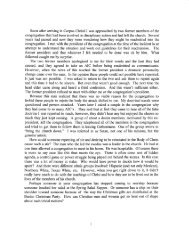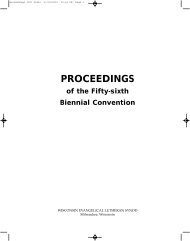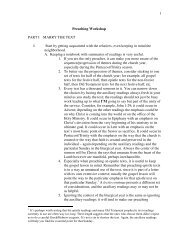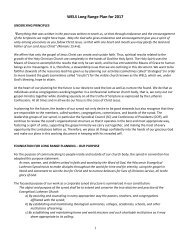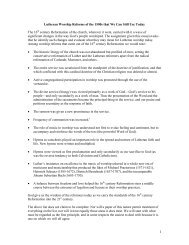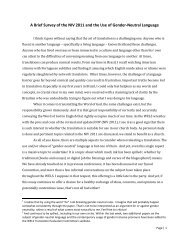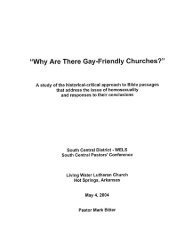A History of the WELS - The South Central District
A History of the WELS - The South Central District
A History of the WELS - The South Central District
You also want an ePaper? Increase the reach of your titles
YUMPU automatically turns print PDFs into web optimized ePapers that Google loves.
included in <strong>the</strong> budget each biennium. This was to eliminate <strong>the</strong> need for special collections and <strong>the</strong> excuses on<br />
<strong>the</strong> part <strong>of</strong> pastors or congregations. Everything was to center on <strong>the</strong> budget. Retirement <strong>of</strong> <strong>the</strong> debt became a<br />
budgeted item. This meant $60,000 added to <strong>the</strong> budget annually. <strong>The</strong> trouble with this plan, as Synod was to<br />
find out, was that <strong>the</strong> member congregations never made <strong>the</strong> ordinary budget for Synod, to say nothing <strong>of</strong> a<br />
budget increased by $60,000!<br />
In <strong>the</strong> years 1921-1927 Synod’s mission work in <strong>the</strong> larger cities was pursued with great vigor, and<br />
insistent cries reached <strong>the</strong> Synod to make funds available for <strong>the</strong> erection <strong>of</strong> churches in <strong>the</strong> newly organized<br />
city missions. <strong>The</strong> 1927 Convention for <strong>the</strong> Synod adopted a resolution to set aside $7,000 as interest for a loan<br />
to be made for <strong>the</strong> Church Extension Fund. $140,000 was borrowed from banks. This money was at once<br />
appropriated by <strong>the</strong> Mission-Boards <strong>of</strong> <strong>the</strong> various <strong>District</strong>s and, to meet <strong>the</strong> ever increasing demands,<br />
additional $50,000 was borrowed to be loaned to mission congregations. Thus about $400,000 was loaned to<br />
needy congregations by <strong>the</strong> Church Extension Fund, on $200,000 <strong>of</strong> which <strong>the</strong> Synod paid a high rate <strong>of</strong><br />
interest.<br />
<strong>The</strong> understanding was that <strong>the</strong> congregations which had received help from <strong>the</strong> Church Extension<br />
Fund were to pay back <strong>the</strong>se loans in a reasonably short time, so <strong>the</strong> Church Extension Fund could have funds<br />
to loan to o<strong>the</strong>r needy congregations. <strong>The</strong> problem was that <strong>the</strong> Fund didn’t rotate. <strong>The</strong> fund was loaning more<br />
money than it was receiving ei<strong>the</strong>r from contributions or payment <strong>of</strong> loans. <strong>The</strong> Church Extension Fund was<br />
becoming over-extended. <strong>The</strong>n came <strong>the</strong> collapse <strong>of</strong> 1929, and as a result <strong>of</strong> <strong>the</strong> depression, <strong>the</strong> Church<br />
Extension loans were frozen and <strong>the</strong> Synod had to pay high interest on <strong>the</strong> $200,000 it had borrowed from<br />
banks.<br />
Ano<strong>the</strong>r contributing factor was Synod investments. Various funds <strong>of</strong> Synod had been invested and <strong>the</strong><br />
interest was to be used for synodical expenses. <strong>The</strong>se investments were added to <strong>the</strong> Synodical debt but not as<br />
expenses, because Synod was expecting to get its money back and more through interest. But Synod was not<br />
able to realize <strong>the</strong> returns from its investments. Synod suffered because <strong>of</strong> its investments, as did all investors,<br />
in <strong>the</strong> collapse <strong>of</strong> 1929. <strong>The</strong> lands Synod had invested in were no longer worth what Synod had spent on <strong>the</strong>m.<br />
<strong>The</strong> money Synod had been lending out could not be repaid. All <strong>of</strong> <strong>the</strong>se factors contributed to Synod’s great<br />
debt: <strong>the</strong> Seminary Building Fund goal that wasn’t reached, <strong>the</strong> over-extension <strong>of</strong> <strong>the</strong> Church Extension Fund,<br />
synodical investments, and <strong>the</strong> depression <strong>of</strong> 1929. Dr. Kiessling adds yet ano<strong>the</strong>r contributing factor:<br />
How could such a debt ever have been run up? <strong>The</strong> most charitable answer is that we hadn’t<br />
adjusted ourselves to <strong>the</strong> new times after World War I. Prices had doubled, but contributions to<br />
synod remained in <strong>the</strong> horse and buggy stage—at least with many people. 26<br />
Liquidating <strong>the</strong> Debt<br />
<strong>The</strong> years immediately following <strong>the</strong> collapse <strong>of</strong> 1929 were very rough ones for <strong>the</strong> Synod. <strong>The</strong> debt<br />
continued to increase and would not be liquidated until almost fifteen years later. <strong>The</strong> chief drain on <strong>the</strong><br />
synodical treasury came from salaries and upkeep at institutions and missions, and when cuts in expenditures<br />
were made necessary by greatly reduced income, <strong>the</strong>re was no o<strong>the</strong>r place where <strong>the</strong> Synod had authority to<br />
make cuts except at <strong>the</strong> institutions and in <strong>the</strong> missions. <strong>The</strong> institutions were instructed to make no repairs<br />
except where <strong>the</strong>y were absolutely necessary to prevent serious damage to property. Cuts in salaries were<br />
made at intervals, in one instance a cut across <strong>the</strong> board <strong>of</strong> 20%. <strong>The</strong> total reduction amounted to more than<br />
one-third <strong>of</strong> <strong>the</strong> original salary.<br />
Not only were <strong>the</strong> salaries reduced, <strong>the</strong> payment <strong>of</strong> <strong>the</strong>m was <strong>of</strong>ten delayed. Some pr<strong>of</strong>essors were not<br />
paid for two and one-half months. <strong>The</strong> grocers would no longer extend <strong>the</strong>se pr<strong>of</strong>essors credit so <strong>the</strong>y were<br />
literally wondering where <strong>the</strong>ir next meal would be coming from. <strong>The</strong>se truly were “<strong>the</strong> times that tried men’s<br />
souls.” Graduates from <strong>the</strong> Seminary during <strong>the</strong>se years also suffered because <strong>of</strong> Synod cut-backs. With <strong>the</strong><br />
restrictions placed on <strong>the</strong> Mission boards, <strong>the</strong>re were very few new missions opened. In 1935 thirty-two<br />
<strong>the</strong>ological candidates still had no calls.<br />
11<br />
26 Kiessling, Vol. 37, No. 21, October 8, 1950, p. 327.



